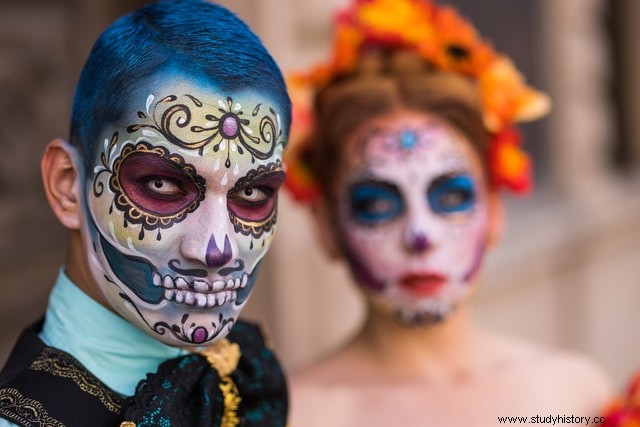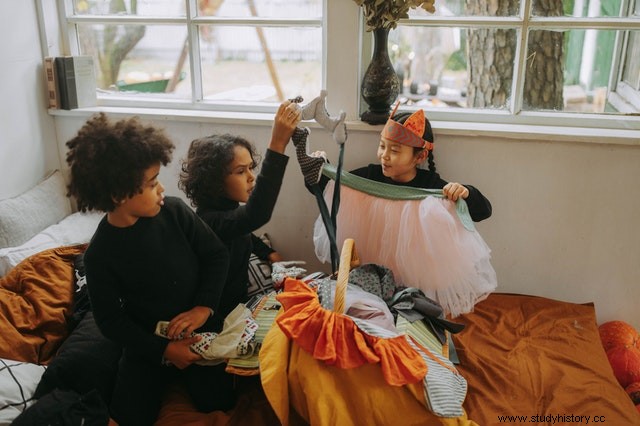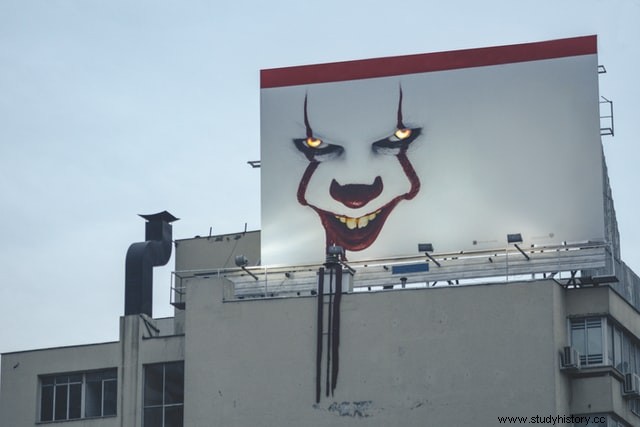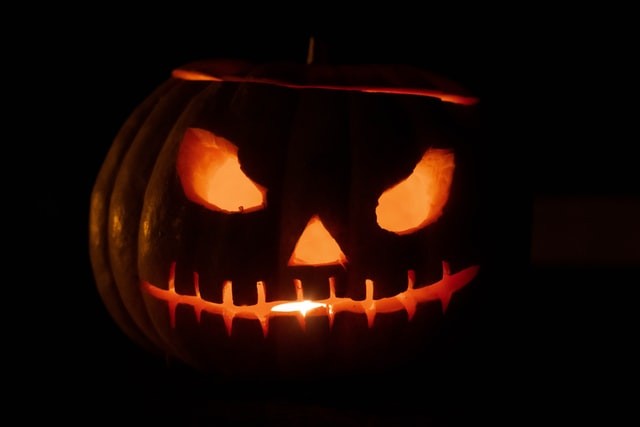Halloween is a holiday that is celebrated every year on October 31st. It has its origins in an ancient Celtic festival called Samhain (pronounced:Sow-in). Samhain was a party where people lit bonfires and danced in costumes to ward off ghosts. During 8 th century and Pope Gregory III's time became November 1 the day to honor all saints.
Today's All Saints 'Day now contains most of Samhain's traditions and is celebrated one day after All Hollows' Eve, which later became Halloween.
Ancient origins
Halloween has, as mentioned in the introduction, a Celtic origin. The Celts lived mostly in Ireland, Britain and northern France. They actually celebrated the New Year on the 1st st November - obviously they did not follow our modern annual calendar. November 1 is the day for the end of summer and the harvest. Finally, it also marks the beginning of a cold and dark winter, which is often and was associated with human death.
The night before New Year's Day, the line between the living and the dead became blurred. Samhain was believed to be the time when the ghosts of the dead return to earth. When these ghosts tread on earthly ground, priests have a greater chance of predicting the future. These prophecies were very important to them because, unlike our modern world, they were solemnly dependent on the volatile world of nature.
Celtic druids built sacred bonfires to burn human and animal corpses as sacrifices to Celtic gods. During this procedure, they wore costumes of animal heads and skins, which are an origin of today's costume on Halloween.
43 AD, in the Roman Empire, two Roman holidays merged with Samhain. One was called Feralia. It was a day celebrated in late October to commemorate the dead. The other was Pomona. Pomona is the Roman goddess of fruit and trees. The fact that her symbol was an apple may explain the tradition of dipping after apples on Halloween.
How Halloween Came to the United States
Early Halloween celebrations were limited in colonial New England because of their Protestant belief system. It was much more common in Maryland and the southern colonies, and to tell ghost stories and mischief.
During the second half of 19 th century, many Irish fled to the United States because of the Irish potato hunger. With the arrival of the Irish in the United States came the celebration of Halloween.
All Saints 'Day and All Souls' Day
The influence of Christianity spread so far into the Celtics that it even mixed with Celtic rituals. All Saints 'Day is also known as All Hollows' Day to commemorate all Church saints.
From 1000 AD and beyond is November 2, the day after All Saints' Day, the day of all souls. All Souls' Day, originally, was a way to replace the Celtic festival of the dead, and was celebrated in the same way as Samhain, with bonfires, parades and costumes. Today is celebrated as a day of prayer and remembrance for the dead.
Halloween myths

Halloween is a holiday filled to the brim with mystery, magic and superstition. Although it started as a Celtic end-of-summer party, it has now become something completely different. However, superstition and mystery are still a big part of it.
One of the superstitions is to avoid crossing paths with black cats, as they bring bad luck. The real reason for this behavior is that people in the Middle Ages believed that witches used to be black cats as a way to avoid detection.
Also, we try to avoid going under a ladder. This may be from the ancient Egyptians. They believed that triangles were sacred. However, walking under a ladder can simply be quite unsafe, which can also be a reason.
Furthermore, most people try to avoid smashing mirrors, stepping on cracks in the roads or spilling salt.
Halloween traditions
Halloween is about celebrating the dead, but the traditions actually focus a lot on the future instead of the past and on the living instead of the dead. There are many traditions, but these two may be the most popular.
Trick or treat

In fact, it was the Europeans who inspired this tradition. They used to walk around town asking for money and food in exchange for singing Christmas carols. Women previously thought they could lure their future husbands with tricks.
During the late 19th century, the Halloween spirit changed. It was now more about community and neighborhood gatherings. At the turn of the century, that changed again. This time to be more about parties for children and adults with toys and seasonal food.
All Souls' Day parades in England may also have been influential, as they were about people walking around the city begging for food. In return for "soul cakes" they prayed for dead relatives.
Finding Romance

Many of the lesser known traditions had to do with young women trying to find their only true match. They thought that if they could identify their future husband this year, they would get married next Halloween. I 18 th century in Ireland, matchmaking chefs buried rings in mashed potatoes in hopes of bringing true love to whoever finds them.
In Scotland, many fortune tellers ask qualified young women to name a hazelnut for each of the men who fit and then throw it into a burning fire. The one who burned to ashes instead of bouncing or exploding represented the future husband.
Another story says that if a young woman ate a sugar mixture made of walnuts, hazelnuts and nutmeg before going to bed on Halloween night, she would meet her future husband in her dreams.
Superstition was great then. Women tried to throw apple peels in the hope that they would land in the form of their future husband's initials, looked at egg yolks, read candles - the list goes on. There were even very competitive rituals, such as that the first to find a burr on a chestnut hunt was the first to get married. Of course, whether we ask for romantic advice or try to avoid seven years of bad luck, each of these Halloween superstitions depends on the goodwill of the same "spirits" whose presence the early Celts felt so strongly.
Halloween around the world
I guess the most popular thing we think of when we hear the word halloween is trick-or-treating in the United States. But there are actually many more ways Halloween is celebrated (or not celebrated) around the world.
North America (USA)

Halloween was actually not a holiday until the 19th th century due to the strict Puritan traditions. But at the turn of the year th century, Halloween became a night of vandalism and cruelty to both animals and humans. Boy scouts and neighborhood organizations began to end the devastation and create a safe gathering.
Today, Halloween is the second largest holiday in the United States, just after Christmas. There are countless parades, and one of the most memorable can be New York's Village Halloween Parade with over 50,000 6 people marching up XNUMX th Allé.
South America (Mexico)

In Mexico, Latin America and Spain, Halloween is not really called Halloween. It is the "Day of the Dead," the Day of the Dead. It is a three-day celebration, from October 31 to November 2, to commemorate the dead.
Most families build an altar for the dead in their families. They honor the deceased and decorate it with flowers, photographs and sweets. Some even add their favorite foods to the dead, so the spirits have a feast when they return to earth.
In addition, candles and incense can help the deceased find his way home. In addition, graves are cleared with new flowers, wreaths and a paper sling. On November 2, relatives show up at the graves to reminisce and have a picnic.
Asia (China)
People in China celebrate the hungry ghost festival in mid-July. They float river lanterns to remember those who have passed. The mainland is less affected than e.g. Hong Kong, since it is generally less influenced by Anglo traditions.
Traditional trick-or-treating is quite difficult in Hong Kong. The vast majority of the city is covered by skyscrapers and high-rise blocks. However, there are some catering companies and managers who organize parties for the children who live in these buildings.
Also, trick-or-treating is a thing in some super-exclusive gated communities, like The Beverly Hills in Discovery Bay.
The Lan Kwai Fong area of Hong Kong is known for its entertainment district for the international community. This is also where Halloween parties and parades have taken place for over 20 years now.
Australia
Halloween is becoming more and more popular in Australia and New Zealand, although it has little or no significance for Australian culture. Actually, they do not want too much American pop culture influence. Since most neighborhoods do not participate in any kind of celebration, some have thought of an idea. They hang up balloons or clear signs indicating that they want to join in and, for example, be a stopper for tricks.
Europe (Ireland)

In Ireland, which is the birthplace of Halloween, it's about cozy get-togethers. Neighbors show up, light a fire, go for a tick-or-treat or visit some of the Halloween parties around. They also play games like snap-apple, treasure hunt or card games.
The traditional Halloween food is Barnbrack, which is a fruitcake with a treat wrapped in muslin, which will predict the eater's future. Whoever finds a ring will soon get married, and whoever finds a straw will have a successful year ahead of him.
Halloween Movies

There are countless scary movies out there, but not all of them are perfect for Halloween. "So, how do we know which ones are?" - Well, I'm glad you asked. Look at the following and put them all on your list.
- Halloween:Michael Myers murders his 17-year-old sister and is sentenced to prison. He escapes on Halloween night and visits his old home. And new goals.
- It:Pennywise is a clown plaguing the city of Derry, Maine. Seven children face him and 27 years later he returns to Derry and the children, now adults, commit to defeat him.
- US:Adelaide Wilson returns to her childhood home. Four masked intruders enter her home, and the family must fight off all the attackers. Slowly they begin to realize who is really under the masks. The Invisible Man:Cecelia's ex-boyfriend is a mad scientist and stages her own suicide, simply to torment her. She is terrorized and the police do not believe a word, and therefore she decides to take matters into her own hands.
- The nun:A young nun takes her own life. The Vatican sends a novice and a priest to find out the truth about the tragic event. The two find out more than they wanted, and their souls will be at stake.
- The Night Warmer:Clarice Starling wants to join the FBI. She is sent to interview a brilliant but violent psychopathic person (Lecter) who is serving a life sentence. Dr. Hannibal Lecter answers all her questions and helps her with the case. The longer the two work together, the worse it gets.
Fun facts about Halloween

- ¼ of all candy in the US is bought for Halloween
- More and more people have started buying costumes for their pets. Nearly $ 490 million was spent.
- Jack o 'Lanterns are descended from the legend of Stingy Jack. He was a man who deceived the devil and was forced to walk on earth with only a burning coal in a hollowed-out turnip as light.
- Top Halloween costumes are a witch, vampire, cat, batman or a ghost. Or, you know, they, how shall I put it, more sexual versions of them all.
- The longest haunted house extends over 3,564 feet underground and is in Lewisburg, Ohio.
- The fear of Halloween is called 'Samhainophobia'.
Halloween in a nutshell
Halloween is much more than what we see on TV or what we know about through social media and news. It is a holiday with a long and deep history. Besides, it was not really "born" in the United States (Springsteen pun), but originated in Europe. It is not celebrated anywhere in the world, but is slowly increasing in popularity.
Whether it's one thing you come from or not, it's definitely worth visiting a Halloween party when you get the chance. Even if you're just doing it for the sake of it.
Feature Image Credit:Toni Cuenca / Pexels
